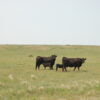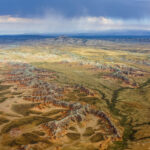Inmates are saving an iconic American landscape—and themselves
By Frani Halperin
On a very windy fall day, Gina Clingerman, project manager for the Bureau of Land Management (BLM) Abandoned Mines Lands program in Wyoming, walks through rolling hills where a wildland fire torched more than 14,000 acres of sagebrush steppe in 2020. Gina estimates that the sagebrush lost in this blaze near the small town of Hanna were probably 100 to 150 years old. But now, she says, they’re, “Dead. Gone. Forever.” That’s an irreplaceable loss for the pronghorn, mule deer, elk, and some 350 other species of wildlife that depend on this ecosystem. The sagebrush landscape, she says, is in peril.
Current estimates are that nearly half of sagebrush ecosystems, the largest interconnected habitat type in America, is gone because of human activities—including roads and urbanization, extractive industries like oil and gas and mining, and devastating fires, which are increasing with droughts and warming temperatures due to climate change. The BLM wants to restore these habitats, and Gina says just scattering seeds on the ground doesn’t work. Among blackened nubs of dead sagebrush, she points out little yellow cages about 12 inches tall, each sheltering a hand-planted seedling. Loose seeds have less than a three percent survival rate compared to the 40 to 70 percent viability of seedlings, but cultivating sagebrush from seed to stem is arduous and time-consuming. Here, Gina and her colleagues got help from a surprising source—inmates from the Wyoming correctional system.

When Levi George was incarcerated at the Wyoming Honor Farm—a minimum-security prison in Riverton, Wyoming—every day starting in April 2021, he and three other inmates made nurturing seedlings the focus of their day. “We mixed the dirt and the soil and made sure the pH levels are where they need to be. And then, we do the seedlings, and then throughout the year, we water and fertilize them,” Levi explains.
Over 6 months, the inmates’ plants grew to about three inches tall. Growing from seeds in the wild, they would have taken five years to get to the same height. In the fall, inmates at the Wyoming Honor Farm shipped out 25,000 sagebrush seedlings to sites around the state where they and partnering organizations planted them by hand.
The Institute for Applied Ecology, a nonprofit organization focused on conservation of native species and habitats, recognized a need for native plants to restore lands following wildfires. Inspired by Evergreen State College’s Sustainability in Prisons Project in Washington, the institute launched the Sagebrush in Prisons program in 2014.
Stacy Moore, ecological educator with the Institute for Applied Ecology, says prison officials were skeptical at first about dedicating resources toward growing a plant that most dismissed as “a weed that grows everywhere.” But after giving the program a try, the staff at the first prison, the Snake River Correctional Institution in Ontario, Oregon, told Stacy that they wanted to double production the next year. “So, that’s what we did, and the next year we went from one prison to five prisons. Then, other prisons saw the benefits and they put up their hand to be involved as well.” The nonprofit now works with 11 prisons in Wyoming, Oregon, Idaho, Nevada, and California.
~
If the only goal was to grow sagebrush, the nonprofit could just do it on their own. But the ability to benefit adults in custody far outweighed the constraints that working with prison populations presented.
“These inmates are soon going to be out in the community, they’re going to be your neighbors, they’re going to be the ones you’re standing in line next to at the grocery store,” Stacy says. “So, we want to give them as many skills as we can before they are released.”
The institute brings in experts at each prison to teach inmates—and staff who also seem eager to learn—about sagebrush ecosystems. At the end of the season, each participant receives a certificate listing the skills they’ve acquired.
Levi says he’d never grown a plant from seed and found the experience therapeutic. “It’s nice to see something grow from nothing.” He adds that working with plants also offered him a place of refuge. “In prison, just like anywhere, everybody is not going to get along. So being able to be away from everyone else and be with the plants and nurture them and watch them grow, to me, it was very soothing.”
The program is so popular that there are not enough spots for everyone who wants to join. The inmates tell Stacy they like the smell of the sagebrush. Some say nurturing the seedlings lowered their blood pressure. Stacy hears that the program has helped reduce violence at facilities. Officers shared about one inmate in Idaho who was so depressed he wouldn’t go outside. His involvement in the program raised his spirts, and he became the lead team member. Prison staff said the program, “brought him out of his shell and saved his life.” Studies show programs like these also reduce recidivism because inmates reenter society with tangible skills, feeling valued.
The experience convinced Levi, who was due to be released within days from the Wyoming Honor Farm when this story was reported and is now at a halfway house, to apply to work for the BLM. “I plan on still continuing to work with them after my release here and try to help other people that’s been in my situation when they get out to have somewhere to start from because it’s hard for felons to get employment sometimes.”
And meanwhile, the tens of thousands of seedlings shipped out from prisons across the West each autumn are putting down their roots to bring back damaged areas of the sagebrush sea.
“It’s just knowing that you had a part of something that you’re giving life to that’s going to hopefully sustain other life form(s),” Levi says, trying to put into words what the program meant to him. “It’s a big deal.”
Fran Halperin is executive producer at H2O Radio. Western Confluence editor Emilene Ostlind adapted this piece from Halperin’s original piece, “How Inmates Are Saving an Iconic American Landscape—and Themselves,” published November 18, 2021, on H2O Radio.


